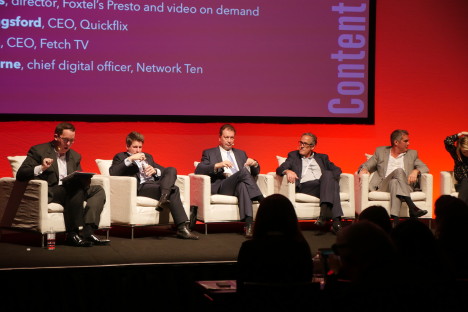Netflix, Stan and Presto streaming services have created a ‘new primetime’ for consumers

State of Streaming panel panel at Mumbrella360 L:R Mumbrella’s Nic Christensen, Stan’s Mike Sneesby, Presto’s Shaun James, Quickflix’s Stephen Langsford, Fetch TV’s Scott Lorson, Tenplay’s Rebekah Horne
Streaming services, such as Netflix, Stan, Presto and Quickflix, have created a “new prime time” as consumer demand surges toward the streaming video on demand (SVOD) services.
Speaking at the Mumbrella360 conference in Sydney, the bosses of a number of streaming players, including Presto, Stan, Quickflix, Fetch TV and Ten Play, agreed they were seeing similar online viewing patterns which included a peak streaming time of between 9pm and midnight.
CEO of Stan Mike Sneesby told the room: “We look at our viewing times and our viewing cycles, both daily and weekly, and one of the things we’ve seen very clearly is effectively the creation of a new primetime.
“It starts almost like a brick wall at 9pm, which coincides with those consumers who watch their news, their current affairs, their favourite reality shows, their favourite Australian dramas… then tune into an on-demand service after that. And that runs right through to around midnight, where it tails off very quickly.”
Director of Foxtel’s Presto Shaun James agreed saying they had seen a similar phenomenon, which will inevitably have flow-on effects on other sectors of the market.
“That kind of later-evening primetime is very similar to what we’re seeing as well,” he said.
“You’re looking at comparing in a very narrow window. You’re saying ‘what’s the effect of these services’, solely on linear television.
“There’ll be an impact on the DVD market which we’ve already seen in decline, there’ll be an impact on gaming – there’s so many things that a streaming service can take people away from. But what we’re seeing in the early days too is that it’s complementary.”
The discussion on changing consumer viewing habits came off the back of a question asking whether VOD services are taking consumers away from traditional free to air networks.
Quickflix CEO and founder Stephen Langsford telling the conference that while new content is always in demand, customers will often want to watch it months, even years later.
“I’m constantly amazed how much demand there is for content that we’re streaming that’s readily available on free to air, or has previously been available on free to air.
“FTA and broadcasters play a great role in building awareness around content, and I think a lot is said about Game of Thrones (GoT) on Foxtel,” he said.
“When Got becomes available for transactional streaming at season finales, we see huge demand. I think we often think demand for content is only there when it’s new, whereas we see strong demand for content years after it’s been launched.”
Speaking from the free to air perspective, Channel Ten’s chief digital officer Rebekah Horne said it’s important to focus on where each network has its strengths.
“The important thing with free to air is to focus on where its strength is, which is in sport and live TV experiences. Things that you can’t miss, i.e. MasterChef, Celebrity, or renovation shows, or whatever the things are that are part of the narrative,” she said.
“What we’ve found with our prime-time viewing is that a lot of our catch-up viewing is similar pattern. People are watching television, then they’re using catch-up at about 9-9:30, and that runs right through to 11.”
Sam Buckingham-Jones




Ten Play being represented in a streaming presentation is a joke. It is a catch up service only and a pretty poor one at that.
I would doubt the traffic for Ten Play is even a tenth of Netflix. It is also not even in the same universe as Netflix or Presto for quality, volume of content or platform reliability or stability.
User ID not verified.
Doesn’t this just suggest that late night programming on free to air needs a shake up? I’d certainly rather watch older content I know I’m going to enjoy than 95% of what is on offer come 8.30pm/9pm…even if it is years old.
Although Netflix has the market share, the Aussie streaming services actually have great content just unfortunate its not all collated on one platform. Take up all the free trials I say. These guys are now offering a 60 Day Presto trial: http://whichflix.com.au/presto-free-trial/
User ID not verified.